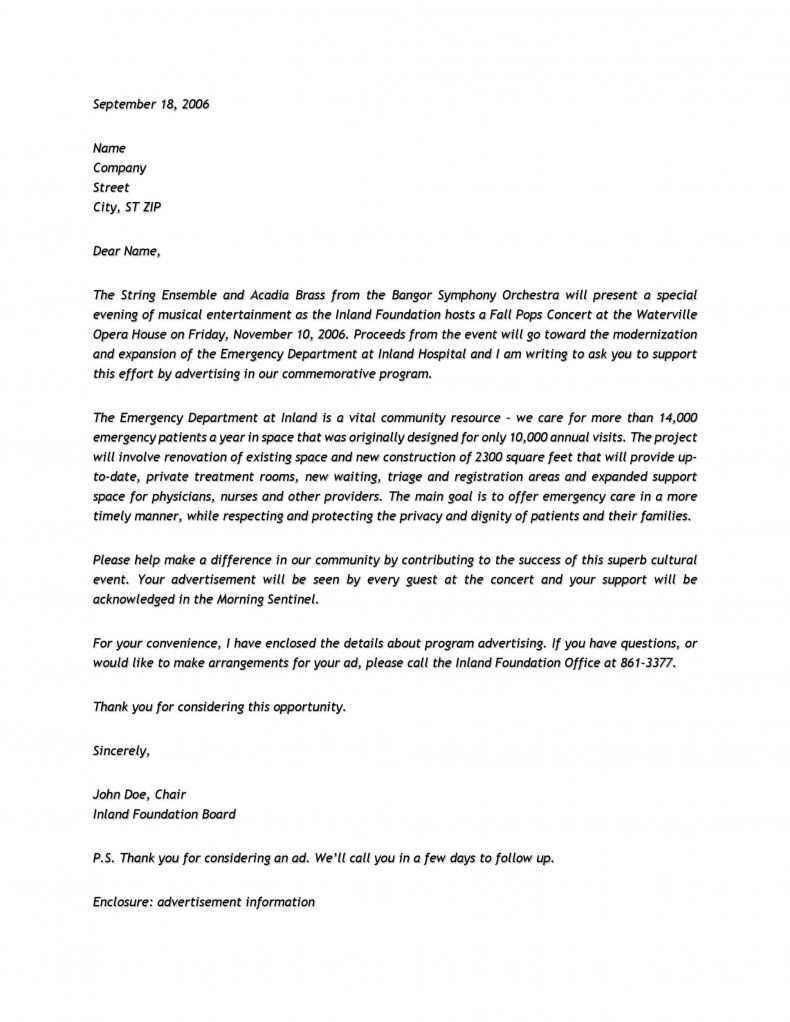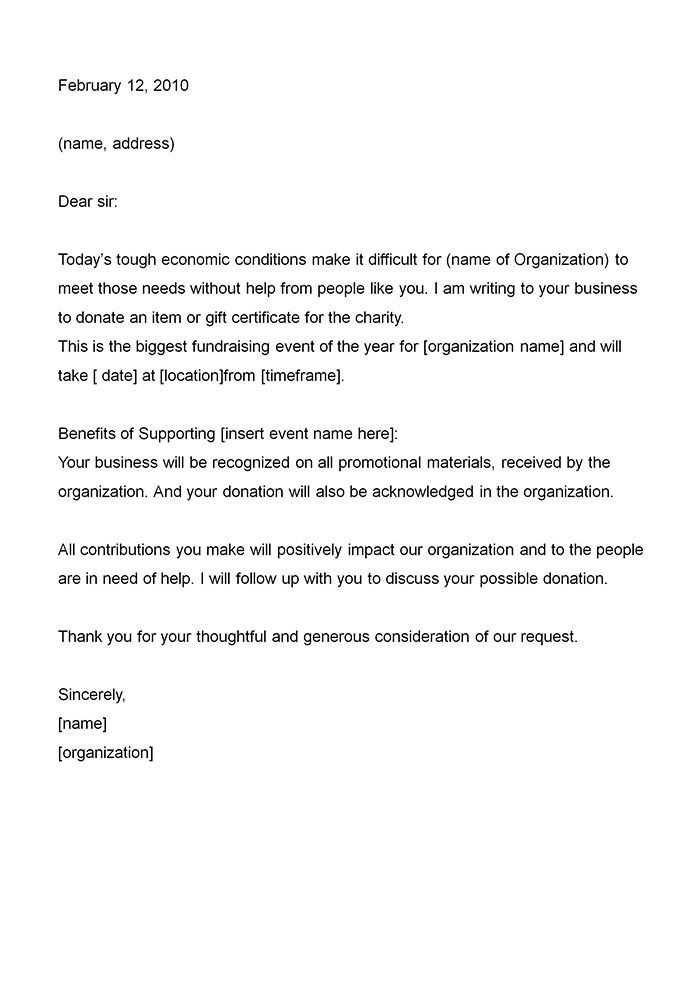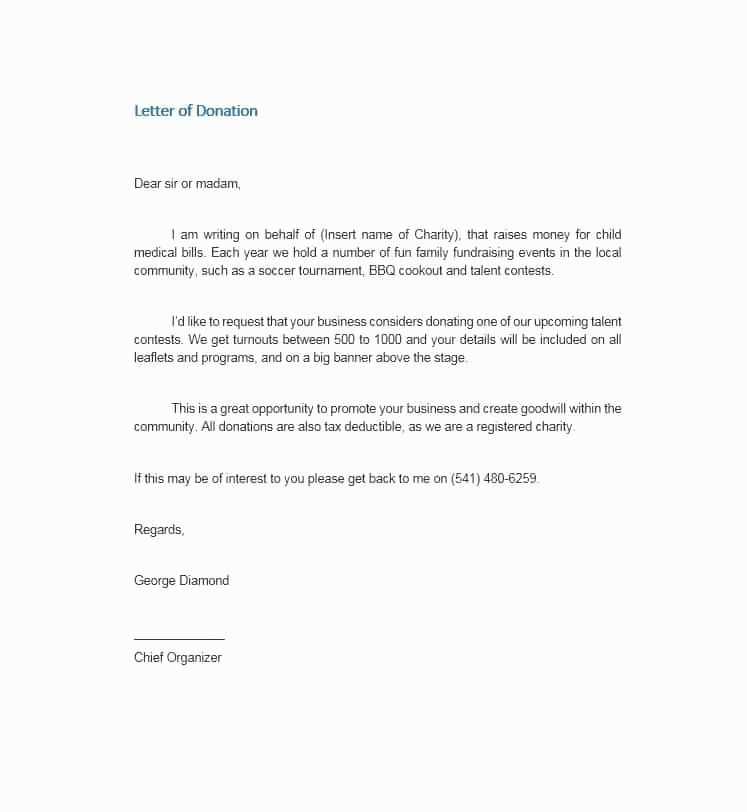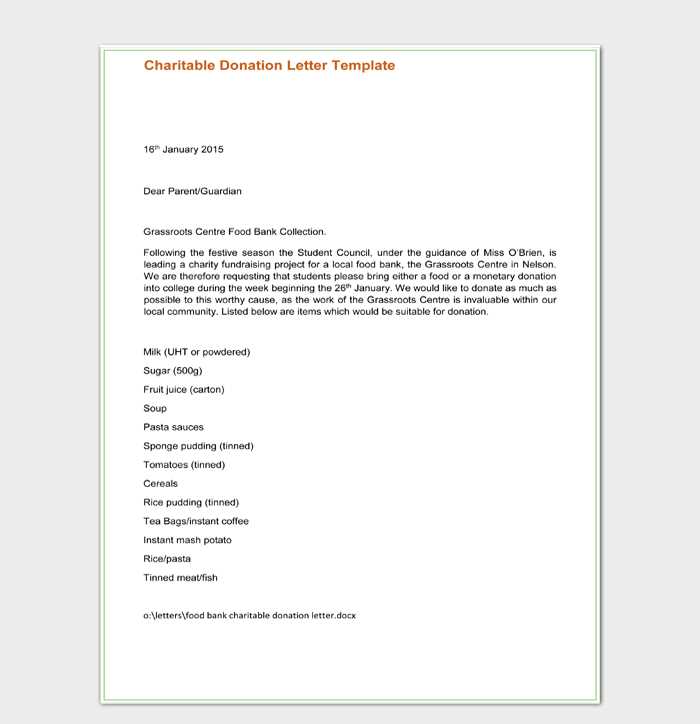Charity Request Letter Template for Effective Fundraising

When seeking support for a cause, the way you communicate with potential donors can make all the difference. Crafting a compelling message is key to inspiring generosity and securing contributions. Whether you’re aiming to fund a local initiative, support a global effort, or help those in need, the approach should be thoughtful, clear, and persuasive.
Effective communication involves not only explaining the purpose of your cause but also connecting emotionally with your audience. It’s important to express the impact of their support, ensuring they feel a personal connection to the mission. A well-written appeal can motivate people to act and make a tangible difference.
In this guide, you’ll find advice on how to structure your message, what tone to use, and how to ensure your appeal resonates with your audience. We’ll also explore common errors to avoid, so your communication stands out for all the right reasons. With the right approach, you can turn words into action and gather the resources needed to fuel your vision.
How to Write a Fundraising Appeal
To successfully reach out to potential donors, your message must be clear, engaging, and concise. The key is to capture their attention from the very first sentence and provide them with a compelling reason to contribute. A well-structured communication not only conveys the purpose of your cause but also demonstrates why their involvement is crucial for achieving your goals.
Start with a strong opening that immediately addresses the reason for your appeal. Introduce the cause, the people or communities it serves, and the specific need you are trying to meet. Ensure that the recipient understands the urgency of your cause, and why their support can make a difference.
Follow with clear details about how the funds or resources will be used. Donors want to know their contribution is going towards a well-thought-out plan. Provide transparency and specific information to build trust and show that the donation will have a tangible impact.
Conclude with a personal touch by expressing gratitude and offering ways for the donor to stay connected or involved in the progress of your mission. A warm closing helps leave a positive impression and encourages long-term engagement.
Key Elements of a Successful Appeal
When composing a persuasive message, it’s essential to include several critical elements that will make your communication stand out and encourage action. A successful appeal should grab the reader’s attention, clearly explain the cause, and provide a straightforward call to action. These key components help ensure your message resonates and motivates the recipient to contribute.
1. Clear Purpose and Focus
Start by articulating the reason for your appeal. The message should clearly convey what you’re seeking, whether it’s financial support, goods, or services. Keeping the focus tight allows the reader to quickly grasp the need and understand its importance.
2. Engaging and Persuasive Content
Donors are more likely to act if they feel a personal connection to the cause. Use storytelling or emotional appeals that help them understand the impact their involvement will have. This personal touch can inspire action and encourage generosity.
- Tell a story that illustrates the importance of your mission or the struggles those you’re helping are facing.
- Highlight outcomes by showing how donations will make a tangible difference and directly support the cause.
3. Clear Call to Action
Be direct about what you want the recipient to do. Whether it’s making a donation, volunteering time, or providing resources, make the next steps obvious and simple to follow. Include clear instructions and any necessary links or contact details.
- Make it easy for recipients to take action, providing links or phone numbers for immediate response.
- Set a deadline to create urgency and motivate recipients to respond promptly.
Personalizing Your Appeal
Tailoring your message to the recipient is one of the most effective strategies for engaging potential supporters. Personalization goes beyond using the donor’s name–it involves crafting a message that speaks directly to their interests, values, and previous involvement with your cause. This approach helps create a deeper connection and shows that you’ve taken the time to understand their role in supporting meaningful initiatives.
1. Address the Recipient by Name
Using the recipient’s name in the opening lines instantly creates a sense of familiarity and respect. A personalized greeting not only shows attentiveness but also increases the likelihood that the message will be read thoroughly.
- Begin with a friendly yet respectful salutation, such as “Dear [Name],” to set a positive tone.
- Avoid generic greetings like “To Whom It May Concern” or “Dear Sir/Madam” to make the communication feel more tailored.
2. Reference Past Involvement or Interests

When possible, refer to the recipient’s past contributions or actions. This could include mentioning a previous donation, participation in an event, or a shared interest in a particular cause. Acknowledging this history reinforces their commitment and helps you build on that connection.
- If they’ve donated before, mention how their support made a difference and highlight the impact of their past contributions.
- If they’re new to the cause, express genuine enthusiasm for their interest and explain why their involvement would be so valuable.
3. Align with Their Values
Understanding the values and motivations of your audience allows you to align your message with their personal or organizational priorities. When you can demonstrate that supporting your cause aligns with their mission, the appeal feels more relevant and compelling.
- Research the recipient’s philanthropic interests to make your appeal resonate more deeply.
- Frame your message in a way that shows how their involvement will contribute to shared goals.
Common Mistakes to Avoid in Appeals
When reaching out for support, even small errors can undermine the effectiveness of your message. Avoiding common pitfalls ensures that your communication is professional, persuasive, and respectful, which increases the likelihood of a positive response. It’s important to be mindful of both the content and tone of your appeal to make a lasting impression.
1. Being Too Vague or General

One of the most significant mistakes is not clearly stating what you need and how the recipient can help. If the message is too vague, potential supporters might not understand how their involvement can make a difference or even feel unsure about what action to take.
- Be specific about the donation amount or type of help you need, whether it’s monetary contributions, volunteering, or resources.
- Provide clear instructions on how to get involved or donate, including links, phone numbers, or addresses.
2. Overloading the Recipient with Information
While it’s important to provide details, too much information can overwhelm your audience. Keep the message concise and focused on key points, ensuring that the recipient can easily grasp the purpose and take action without feeling burdened by unnecessary details.
- Focus on one main message–avoid including irrelevant information that might distract from the main goal.
- Use bullet points or lists for easy readability and to break up text for clarity.
3. Using a Generic or Impersonal Tone
Sending a message that feels impersonal can reduce its impact. Avoid overly formal or generic language that doesn’t connect with the reader. Instead, aim for a tone that’s warm, respectful, and tailored to the recipient’s relationship with your cause.
- Avoid clichés and overly scripted phrases that sound insincere.
- Be conversational while maintaining professionalism–this helps create a more personal and engaging appeal.
Best Practices for Requesting Donations
When reaching out for support, it’s essential to follow best practices that not only make your appeal effective but also build a strong foundation for lasting relationships with your donors. An impactful message communicates the value of the cause, respects the donor’s time, and provides a clear path to involvement. By following these guidelines, you can enhance the chances of securing the resources needed to support your initiative.
1. Be Transparent and Honest
Donors want to know exactly where their contributions are going and how their support will be used. Transparency is crucial to building trust and confidence. Clearly outline the goals, the impact of donations, and how funds will be allocated.
- Show the benefits of the donations, whether they help with specific projects, services, or outreach.
- Provide updates on how past donations have been utilized and the results achieved, which reinforces accountability.
2. Create a Sense of Urgency
While it’s important to be respectful, it’s also essential to convey the urgency of your needs. A time-sensitive appeal can motivate potential donors to act quickly and make an immediate impact.
- Set a deadline for donations to create a sense of urgency and show the importance of timely action.
- Explain the consequences of delayed support or the potential for missed opportunities to highlight why a prompt response matters.
How to Address Potential Donors
When reaching out for support, the way you address potential contributors plays a significant role in how your message is received. A respectful, personalized approach can foster trust and build rapport, making it more likely that the recipient will respond positively. It’s crucial to acknowledge the recipient’s past involvement or show genuine interest in their values and contributions.
1. Use a Personalized Salutation
Starting with a personalized greeting helps create a connection with the recipient and shows that you’ve put thought into the communication. Avoid generic greetings, as they can make the message feel impersonal and less engaging.
- Use the recipient’s name whenever possible to add a personal touch.
- Consider their title or preferred form of address, especially in professional settings, to show respect.
2. Acknowledge Their Past Support or Interests
Recognizing past contributions or aligning the message with the recipient’s interests can create a sense of appreciation and continuity. This shows that you value their previous support and are not simply reaching out for the first time.
- Refer to past donations or actions if applicable, highlighting their impact on the cause.
- Express enthusiasm for their potential involvement, connecting it with their personal or organizational interests.
Examples of Effective Appeals
Reviewing well-crafted examples can provide insight into how to structure your own message. A strong appeal combines clarity, urgency, and emotional appeal to engage the recipient and motivate action. Below are examples of effective approaches that have successfully inspired support for various causes.
1. Example for Financial Support
This type of appeal clearly defines the need for funding, emphasizes the urgency, and highlights how the donation will be used to achieve specific goals.
| Opening Statement | Dear [Name], |
|---|---|
| Purpose | We are reaching out to you to help fund our upcoming initiative, which aims to provide essential resources to underserved communities. |
| Specific Need | Your generous donation of $100 will provide 10 children with the education materials they need to succeed in school this year. |
| Call to Action | Please consider making a donation today to help us reach our $5,000 goal by the end of this month. |
| Closing | Thank you for your continued support. Together, we can make a lasting difference. |
2. Example for Volunteering Support

This type of appeal focuses on requesting volunteers’ time and effort, emphasizing the personal impact and importance of their involvement.
| Opening Statement | Dear [Name], |
|---|---|
| Purpose | We are currently recruiting volunteers to help organize our community event that will benefit hundreds of local families. |
| Specific Need | We are looking for volunteers who can assist with event setup, registration, and supporting activities on the day of the event. |
| Call to Action | If you are available to volunteer, please sign up on our website or contact us directly to learn more. |
| Closing | Your participation will make a significant difference, and we truly appreciate your time and dedication to our cause. |